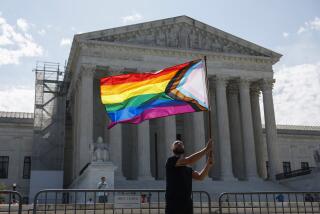‘Married With Children’ Still Fading as a Model
- Share via
Americans in the 1990s continued a 30-year trend away from the traditional married-with-children model, a movement that is gradually rewriting the notion of family, census data released today show.
Households composed of unmarried partners became strikingly more common, growing by almost 72%--nearly five times as fast as the number of households overall. The number of Americans living alone grew almost twice as swiftly as the population, surpassing 27 million.
For the record:
12:00 a.m. May 17, 2001 FOR THE RECORD
Los Angeles Times Thursday May 17, 2001 Home Edition Part A Part A Page 2 A2 Desk 2 inches; 45 words Type of Material: Correction
Census data--A story on the 2000 census in Tuesday’s Times misstated the number of Americans who live together without marrying. The number is 10.8 million, based on the number of unmarried-partner households, which is 5.4 million. The 72% increase in such households during the 1990s was correctly stated in the story.
In most other categories, social changes that began churning under the nation’s roofs during the 1970s and 1980s continued at a gentler pace in the last 10 years.
Fewer than one in four households now consist of married couples and their children, a slight dip from the previous count. Households headed by single mothers increased by more than 25%. Those headed by single fathers, though still a demographic rarity, surpassed the 2 million mark, up almost 62%.
Despite glimmers in other data suggesting that traditional nuclear families staged a late 1990s comeback, the millennial census described a nation of increasingly complex and extended family trees.
“Nowadays, on school forms they have space to put two separate households,” said Zena Polly, an Irvine psychologist who counsels single parents and families riven by divorce. “The term unusual no longer applies.”
The number of Americans who live together without marrying remains small: 5.4 million, only 1.9% of the total population. But the dramatic rise in their number reflects deepening divorce trauma and how formalized unions have lost much of their functional and economic necessity in the last three decades, demographers said.
“Young pre-marrieds are kind of shellshocked from their own families,” said David Popenoe, a Rutgers University sociologist, who heads the National Marriage Project and writes the annual State of Our Unions report.
Changing mores have made living together a mainstream option, even for those raised to think of it as living in sin, said Morton Alexander, a widower friendly with several unmarried senior couples cohabiting in the Leisure World community in Laguna Woods.
“At our age, marriage comes with even more legal and financial complications,” he said. “We need companionship and we’re not going to have kids.”
Frederick Hertz, an Oakland real estate attorney and author of “The Living Together Kit: A Legal Guide for Unmarried Couples,” said that 15 years ago he dealt almost exclusively with gay couples and hippies.
The statistics unveiled today--the first release of Census 2000 family data--do not distinguish between same- and opposite-sex couples and are not sorted by age. But other studies have found sharp increases in opposite-sex cohabitation.
Hertz said his clients are increasingly older, more affluent, more likely to have children and more inclined to see living together as an alternative to marriage, rather than a prelude to it.
“It’s not just the numbers, it’s the nature of the couples that has changed,” he said.
If rising cohabitation numbers reflect the nation’s fragile confidence in marriage, then swelling figures for single-parent and non-family households reflect the consequences of layer upon layer of divorce, Popenoe said.
Those who live alone or with nonrelatives rose 23% in the ‘90s and now constitute almost one in three households. Longer life spans and a record prosperity enabled more Americans to live independently, demographers said.
Single-parent households grew 32% in the 1990s, though far less swiftly than in previous decades and minus much of the controversy and angst of the “Murphy Brown” era. “Serial parenting,” as Polly calls it, has become a new norm.
“Their concern now is mainly over how their lifestyle is going to affect their children’s preparation for relationships,” she said. “They wonder, do I need to convey that there’s something missing from our lives, or should I convey that we are whole, but when you grow up I hope you find a partner.”
The surge in single-parent households headed by fathers echoed a similar one in the 1990 census.
Sociologists say courts have become friendlier to fathers seeking custody, and the national fatherhood movement has prompted an unprecedented exploration of fathers’ roles and rights. A 1998 census report found that 16% of children in single-parent homes lived with their fathers, up from about 5% 20 years earlier, Popenoe said.
“Our parenting classes are full of fathers,” said Arnie Engelby, director of the Resource Center for Fathers and Families in Minneapolis. “Society has kind of looked on mothers as the primary caregivers and fathers have felt that’s the way it should be. But as time has passed, society is saying it’s OK for fathers to have their children, and fathers are proud to have that role.”
Some family advocates mourned the census figures, saying that they depict an American family growing increasingly frayed and fragmented. Children raised in such circumstances are more likely to experience turbulence and disadvantage, said Jennifer Manlove, senior research associate for ChildTrends, a Washington consulting firm.
But other leading sociologists said they suspect the 10-year snapshot, frozen in April 2000, may have obscured a return to more traditional ways.
The Census Bureau’s most recent Current Population Survey indicated that the percentage of children living with married parents stabilized between 1995 and 2000 and the share living with single mothers declined. The nation’s divorce rate steadied and even dipped in the late ‘90s; teenage pregnancy decreased throughout the decade.
“There may have been a turning point,” said Wendell Primus, who studies child well-being at the Center on Budget and Policy Priorities, a Washington research group.
(BEGIN TEXT OF INFOBOX / INFOGRAPHIC)
Living Together
The most dramatic change in American family structure during the 1990s was a 72% increase in the number of households with unmarried partners, according to a Census Bureau report.
*
Note: Figures may not total 100% because of rounding.
Source: U.S. census
*
MORE INSIDE
Golden Years: Census finds elderly Americans thriving. A16
Asians: Indian community doubles, while Japanese numbers drop. A16
More to Read
Sign up for Essential California
The most important California stories and recommendations in your inbox every morning.
You may occasionally receive promotional content from the Los Angeles Times.













